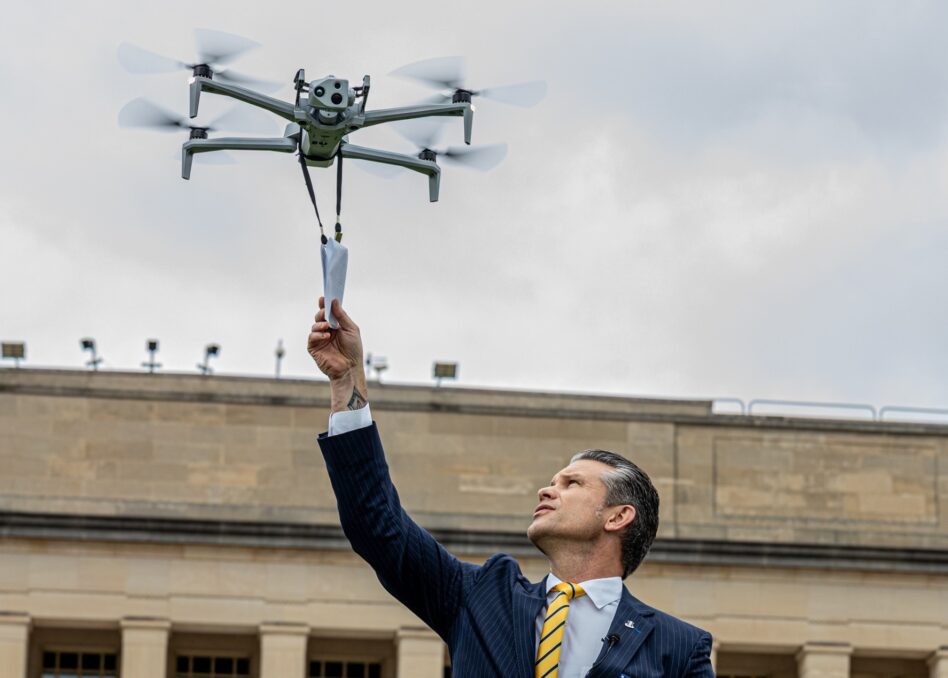Drones are having a moment. Last Thursday, Defense Secretary Pete Hegseth released a memo that the Pentagon would be making some big changes to the way it buys, uses, and trains with drones.
In true showman fashion, he announced the changes in a viral video set to Metallica’s Enter Sandman, posted on X with a drone carrying the paper memo. (The video had to be deleted and reposted “due to a copyright issue with the song,” according to the Pentagon.)
In the video, Hegseth said, “We’re in the fight to win it. And we’re never gonna back down.” Apparently, that doesn’t extend to heavy metal bands.
Drone decree: Hegseth’s memo, titled “Unleashing U.S. Military Drone Dominance,” builds on Trump’s June 6th very-similarly-named executive order, “Unleashing American Drone Dominance.”
That order called for:
- Accelerating commercial drone integration by mandating FAA approval of BVLOS operations, AI-assisted waivers, and expanded UAS test range use.
- Launching of a national eVTOL pilot program to fast-track electric aircraft with local partners and regulatory evaluations.
- Strengthening the drone industrial base by prioritizing U.S.-made systems, securing supply chains, and listing risky foreign entities.
- Boosting exports and military adoption through streamlined controls, financing tools, DoD procurement mandates, and Commerce-led export promotion.
Hegseth’s memo, which seeks to rescind “restrictive policies that hindered production and limited access to these vital technologies,” takes a three-pronged approach:
- First, the Pentagon will “bolster the nascent U.S. drone manufacturing base by approving hundreds of American products for purchase by our military,” including by “leveraging private capital flows.”
- Second, the DoD will arm combat units with “a variety of low-cost drones made by America’s world-leading engineers and AI experts.”
- Third, UAS will be “integrated into all relevant combat training, including force-on-force drone wars,” as part of a broader effort to “simulate the modern battlefield” and “overcome the bureaucracy’s instinctive risk-aversion on everything from budgeting to weaponizing and training.”
Frontline PEOs: To fund this shift, Hegseth also calls for “new funding lines” to address the “urgent need for drones,” as well as a big change to UAS procurement. A memorandum attached to the memo issues new guidance that “delegates authority to our training commands and operational forces and requires a new procurement strategy to facilitate 24-hour modifications by frontline personnel assuming the greatest risk.”
By 2026, the attachment adds, “every squad will have low-cost, expendable drones, prioritizing Indo-Pacific combat units.” How those low-cost, expendable drones would fare in what would likely be a primarily air and naval battle in the South China Sea is another question.
The memo also reclassifies certain small drones as “consumables”—like ammo—reflecting how far Ukraine’s kamikaze-style FPV use has reshaped military thinking.
Drone doubts: Not everyone is sold on this approach, however.
Jacquelyn Schneider, Director of the Hoover Institution’s Wargaming and Crisis Simulation Initiative, cautioned that this memo may not be enough to “Unleash U.S. Military Drone Dominance” for a number of reasons. In a post on X, Schneider wrote, “Some of these have to do with capacity: budget, cybersecurity restrictions, supply chain considerations. But most of them won’t be fixed with a memo.”
Schneider argues that:
- Institutional resistance and unclear demand have long stalled small drone adoption, with military services reluctant or disjointed in defining missions, requirements, and budget lines for such systems.
- Efforts like Replicator and DIU filled the gap, but without sustained service-level funding for procurement and O&M, the defense industrial base won’t scale production.
- Venture-backed firms like Anduril are betting on future demand, but success requires more than funding—it depends on clear strategic priorities, not just copying Israeli or Ukrainian drone use.
- True transformation demands a DOD-wide strategy, congressional reform, and empowered combatant commands, plus long-term leadership beyond the churn of political appointments.
In other words, while the changes are a good first step, a lot of work remains to be done to match China’s (or even Ukraine’s) manufacturing output.

